Disclaimer: This material is being kept online for historical purposes. Though accurate at the time of publication, it is no longer being updated. The page may contain broken links or outdated information, and parts may not function in current web browsers. Visit chandra.si.edu for current information.
Nobel Days and Nights in Stockholm:
From Black Holes to White Ties
by H. TananbaumJanuary 6, 2003 ::
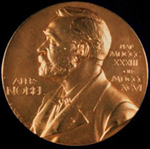 |
In October 2002, we learned that Riccardo Giacconi had been awarded one half of the 2002 Nobel Prize for Physics for his pioneering work leading to the discovery of cosmic x-ray sources. Riccardo was cited for the detection of the first extra-solar x-ray source - Sco X-1 and the discovery of the all-sky x-ray background in a 1962 rocket flight. The Nobel press release also noted Riccardo's efforts to develop the first x-ray telescopes, so essential for the advancement of the field.
Each Nobel winner is permitted to invite fifteen official guests for the festivities in Stockholm, and I was very excited when Riccardo called me (in Dallas where I was visiting my children and grandsons Kyle and Jason) to ask if I would like to take a winter break in Stockholm. Since our family has traditionally traveled from Boston to Buffalo for the winter holidays, Stockholm was right up our alley.
There followed a series of e-mails with particulars about the various activities being arranged, including a detailed form to be completed in metric units to arrange for the formal (tails and white tie) garb required for the Awards Ceremony and Banquet. Lucky for me that I knew how many cm per inch and how many kg per pound - one never knows when all of that formal training in physics and math may be needed.
In addition to Riccardo's wife Mirella, his daughters Guia and Anna and their husbands Jonathan (Trutter) and Ed (Baize) and Riccardo's grandchildren Colburn (Colbe) and Alexandra (Nicki) represented the Giacconi family. Long time collaborators, Herb Gursky, Ethan Schreier, and myself, along with our wives Flora, Janet, and Rona, respectively, and Giacconi family friends Marvin and Joan Cornblath comprised the rest of Riccardo's guest list.

NASA's UHURU Satellite |
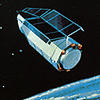
Einstein X-ray Observatory |
Herb Gursky had actually been at the test range and conducted the discovery rocket flight in 1962. Ethan and I had worked with Riccardo on UHURU (the first x-ray satellite) and Einstein (the first x-ray telescope for extra-solar studies), and Riccardo and I had written a 1976 proposal which effectively began the Chandra program.
Riccardo left the Harvard-Smithsonian Center for Astrophysics in 1981 to become the first Director of the Hubble Space Telescope Science Institute, and subsequently served as Director General of the European Southern Observatory. He is now President of Associated Universities Inc.
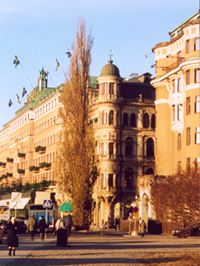
Grand Hotel, Stockholm (Photo: CXC) |
Family and friends arrived in twos (and fours) in Stockholm with all of us staying at the magnificent Grand Hotel right on the water. Stockholm is a series of islands surrounded by rivers and seas. Rona and I arrived in the afternoon on the 7th just in time to be transported to a reception hosted by the Royal Swedish Academy of Sciences at Stockholm University.
At the reception, we met Professors Per Olaf Lindblad and Bengt Guftafsson who were very excited over the fact that this year's Prize recognized work done in Astrophysics. The science staff at the University had downloaded information covering the time from the initial rocket flight to the present Chandra data and had superb displays of the instrumentation and science highlights. Riccardo did engage us all in an animated discussion when he noted a statement that future x-ray missions might prove the existence of black holes, since he and most of us involved in X-ray astronomy feel that the case has already been made. A lively dialog ensued, which we all enjoyed.
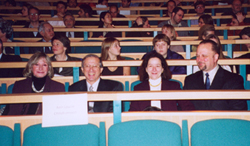
Rona and Harvey Tananbaum and Anna and Ed Baize (left to right) Anticipate Riccardo's Lecture (Photo: CXC) |
On Sunday morning, we rose early and left the Grand Hotel (by tourbus) for the Nobel Lectures in Physics, again at Stockholm University. The first two lectures involved neutrino research done by Raymond Davis and Masatoshi Koshiba. Ray Davis was able to attend, but due to health reasons his lecture was presented by his son. Having arrived early, we had primo seats for this events.
Riccardo delivered a magnificent presentation starting from the discovery of Sco X-1 and the X-ray background in 1962 and describing the chase to understanding these mysterious findings. He presented data from the UHURU satellite showing how work by him, Ethan Schreier, myself and others had led to the discovery of rapid variability in several sources including Cen X-3, Her X-1, and Cyg X-1. He also showed data on Her X-1, Cyg X-3, and Cyg X-1 obtained at high signal to noise with precise timing capability in a 1973 rocket flight by the Goddard Space Flight Center x-ray astronomy group. In the UHURU observations of Cen X-3 and Her X-1, regular pulsations were seen, establishing the presence of a neutron star. Regular changes in the pulse period and x-ray eclipses showed that the X-ray sources were in binary systems. Along with the speed-up of the pulse period these data pinned down the energy source as gravitational energy released when matter from the "normal" star falls onto the neutron star, just as energy is released when a book drops on the floor under the force of gravity.
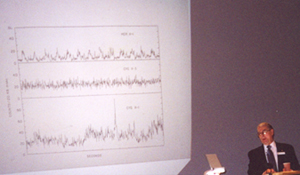
Data on Her X-1, Cyg X-3, and Cyg X-1 from a 1973 rocket flight by the Goddard Space Flight Center X-ray astronomy group (Photo: CXC) |

Graph showing increasing numbers of x-ray sources as one goes fainter and fainter with better telescopes. (Photo: CXC) |

Giacconi family and friends at lunch (Photo: CXC) |
For Cygnus X-1, the intensity changes were more rapid and irregular, and radio and optical observations soon led to the realization that the x-ray source was several times heavier than our Sun, too massive to be a neutron star and therefore a black hole.
Riccardo went on to explain that observations with X-ray telescopes on the Einstein, ROSAT, ASCA, and Chandra missions have detected many fainter X-ray sources mostly associated with supermassive black holes at the centers of quasars and other active galaxies. The collected output from these faint sources explains most of the X-ray background discovered in 1962.
After this marvelous lecture (during which Riccardo generously shared credit with many of those who had contributed to the development of the field), Riccardo invited us all to lunch at a local Italian restaurant. There we enjoyed a delightful lunch while remembering many "war stories" from the early days of X-ray astronomy.

Riccardo Receiving Award From the King (Photo: Hans Mehlin, Nobel e-Museum) |
Later, while the Giacconis were attending numerous official lunches and dinners, the rest of us had time to visit several of the fantastic museums in Stockholm and to enjoy some amazing cuisine - Ethan made sure that we really enjoyed this portion of our visit. We also caught up with former SAO team members Joe Schwarz and Ginevra Trinchieri who were in Stockholm as guests of their longtime friend Bob Horvitz, co-winner of the 2002 Prize for Physiology or Medicine.
On Tuesday, December 10 the big events were at hand. Formal gowns and tails and the like were rolled out, and we rode the tourbus to the Stockholm Concert Hall. We had an excellent view of the Prize Award Ceremony (first row, center in Second Balcony - akin to the Fenway Park bleachers in some ways, but certainly with a better-dressed crowd). Riccardo and the others received their awards, shaking hands with the King and making sure that all of the protocols were followed. Citation were read in Swedish and attendees were provided with English translations.
Then we were transported to Stockholm City Hall, where the Banquet was held in the Blue Hall, which looks a bit like a medieval castle. We found our assigned seats and then watched as the Royal Family and the Prize Winners marched into the Hall. Dinner was magnificent - with venison as the main course and wonderful first dishes and dessert, along with a series of superb wines. Entertainment was provided between courses by a circus troupe who were able to do some amazing dances and acrobatics in the Hall which is not normally equipped for such activity. After dinner there was dancing in the Gold Room with more time to socialize.
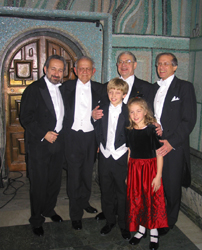
Ethan, Herb, Riccardo, Harvey and Riccardo's Grandchildren, Colbe and Nicki (Photo: E. Schreier) |
After the formal banquet our group (and those with the other Prize Winners) were invited to an after-the-party party (Nobel Nightcap) hosted by the graduate students in economics this year. Most of us were able to make this party, and Ethan, Janet, Rona, and yours truly even made the party after the after-the-party party. Twas a long day (actually short day and long night) and a fun time!!
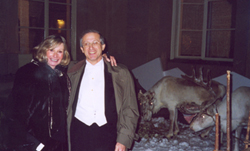
Rona and I with two of Santa's Helpers (Photo: CXC) |
On Wednesday we slept late and met the Giacconis for lunch. Then Riccardo was off to transact business (make arrangements for his half of the Prize Award). Riccardo and Mirella had dinner with the King and Queen again that evening while Ethan found another splendid restaurant for us. While there was another official (white tie, tails, and gowns) dinner on Friday, called the Lucia Dinner and hosted by the Student Union of Stockholm University, Rona and I headed home on Thursday Dec 12, which just happened to be the anniversary date for the launch of UHURU.
On a personal note, I am delighted that Riccardo's pioneering work and vision have been rewarded with this Prize. Those of us working on Chandra and in the field are incredibly pleased to see X-ray astronomy recognized through the Nobel Prize. Stockholm was indeed wonderful (and essentially snow-free during our visit) and this was truly a memorable event.
Related Chronicle Articles:
Disclaimer: This material is being kept online for historical purposes. Though accurate at the time of publication, it is no longer being updated. The page may contain broken links or outdated information, and parts may not function in current web browsers. Visit chandra.si.edu for current information.




